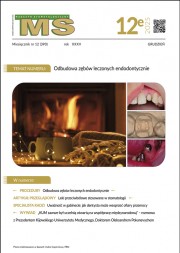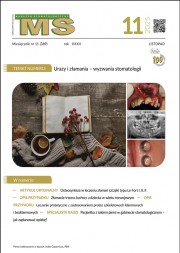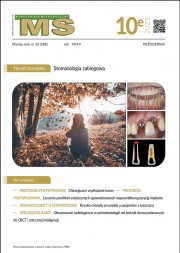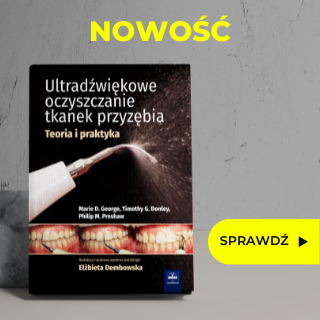Opublikowano dnia : 17.05.2025
Dostęp do tego artykułu jest płatny.
Dostęp do tego artykułu jest płatny.
Zapraszamy do zakupu!
Cena: 24.00 PLN (z VAT)
Kup artykuł
Po dokonaniu zakupu artykuł w postaci pliku PDF prześlemy bezpośrednio pod twój adres e-mail.
TEMAT NUMERU
Protokół postępowania
Kliniczna i cyfrowa ocena uśmiechu
Subir Banerji i Shamir B. Mehta, Andrea Shepperson
- Kliniczna ocena uśmiechu.
Zasady
Podczas gdy wprowadzanie zmian estetycznych w odniesieniu do uniwersalnych określonych koncepcji może być stosunkowo proste, to gdy w grę wchodzą bardziej subiektywne zmienne, może to nie być takie łatwe.
Ważne jest, aby poznać dokładne potrzeby pacjenta. Można to osiągnąć początkowo po- przez przeprowadzenie wywiadu z nim. Po- mocny może być również szczegółowy kwestionariusz oceny uśmiechu.
W celu uzyskania przewidywalności potrzebna jest technika, która umożliwi wszystkim stomatologom odwracalną wizualizację wszelkich planowanych zmian estetycznych, uzyskanie świadomej zgody i unikanie nierealnych oczekiwań. Jedną z takich technik jest „wewnątrzustny mock-up” lub „wysusz i wykonaj próbę”.
Piśmiennictwo:
1.Tarnow DP, Magner AW, Fletcher P. The effect of the distance from the contact point to the crest of bone on the presence or absence of the interproximal dental papilla. J Periodontol. 1992 Dec;63(12):995–6.
2.Johnston C, Burden D, Stevenson M. The influence of facial midline discrepancies on dental attractive- ness ratings. Eur Jour Ortho. 1999;21:517–22.
3.Dias N, Tsingene F. SAEF-smile aesthetic evaluation form: a useful tool to improve communication be- tween clinicinans and patients during multidisci- plinary treatment. Eur Jour Esthet Dent. 2011;6:160– 75.
4.Miller E, Bodden W, Jamison H. Dentofacial perspec- tive. Br Dent Jour. 2005;199:81–8.
5. Rufenacht C. Fundamentals of esthetics. Chicago, IL: Quintessence; 1990.
6. Fradeani M. Esthetic analysis: a systematic approach to prosthetic treatment. Chicago, IL: Quintessence; 2004.
7. Magne P, Belser U. Bonded porcelain restorations in the anterior dentition: a biomimetic approach. Chica- go, IL: Quintessence; 2002.
8. Bhuvaneswaran M. Principles of smile design. J Conserv Dent. 2010;13(4):225–32.
9. Morley J, Eubank J. Macroesthetic elements of smile design. J Am Dent Assoc. 2001 Jan;132(1):39–45.
10. Lin WS, Zandinejad A, Metz MJ, Harris BT, Morton D. Predictable restorative workflow for computer-aid- ed-design/computer-aided-manufacture fabricated ceramic veneers utilizing a virtual smile design prin- ciple. Oper Dent. 2015 Jul–Aug;40(4):357–63.
11. Coachman C, Van Dooren E, Gürel G, Landsberg CJ, Calamita MA, Bichacho N. Smile design: from digital treatment planning to clinical reality. In: Cohen M. Interdisciplinary treatment planning, vol. II: compre- hensive case studies. Chicago, IL: Quintessence; 2011. p. 119–74.
12. Gibbs CH, Lundeen HC, Mahan PE, Fujimoto J. Chew- ing movements in relation to border movements at the first molar. J Prosthet Dent. 1981;46:308–22.
13. Lundeen HC, Gibbs CH. The function of teeth: the physiology of mandibular function related to occlusal form and esthetics. Gainesville, FL: L & G; 2005.
14. Bakeman EM, Kois J. The myth of anterior guidance. J Am Acad Cosmetic Dent. 2012 Fall;28(3):56.
15. Gürel G. Applying foundational principles to digital technologies: ensuring success in aesthetic dentistry. Dent Today. 2014 May;33(5):144–8.
16. Gürel G. Discovering the artist inside: a three-step approach to predictable aesthetic smile designs, part 1. Dent Today. 2013;32:74–8.
17. Gürel G. Discovering the artist inside: a three-step approach to predictable aesthetic smile designs, part 2. Dent Today. 2013;32:126–31.














